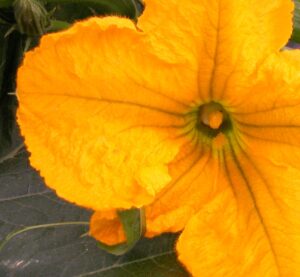 With high temperatures this week and predicted for next week, there are concerns about pollination of pumpkin and other crops. Flower bud abortion can occur if temperatures are in the high 70’s at night or in high 90’s during the day for several consecutive days. Heat stress causes other issues with plant functions and plant health. However, for crops that need pollination, it is especially stressful when hot and dry weather conditions occur.
With high temperatures this week and predicted for next week, there are concerns about pollination of pumpkin and other crops. Flower bud abortion can occur if temperatures are in the high 70’s at night or in high 90’s during the day for several consecutive days. Heat stress causes other issues with plant functions and plant health. However, for crops that need pollination, it is especially stressful when hot and dry weather conditions occur.
Honeybees, bumblebees, squash bees, and many other solitary bees will pollinate pumpkin flowers. Pumpkin flowers only live a few hours after blooming and then go limp and close. Therefore, they must be pollinated during the brief window when they are open. It is important to keep adequate soil moisture during pollination to help foster flower health, pollen quality, and good pollen acceptance by the stigma. Pollination cannot occur if the buds and flowers don’t form properly. Irrigation is recommended, as well as other plant health maintenance practices to keep pumpkin roots, vines, flowers and fruit growing properly during this heat wave and throughout the season.
Some other factors to consider in the future to ensure adequate pollination include:
1. Keep plant populations at recommended rates to not have excessive foliage. The nice thing about pumpkin vines is once they cover the ground, they make for good weed competition. However, too much leaf cover and high plant densities can hinder pollinators from locating flowers under the canopy. Additionally, too much foliage causes plants to remain wet for longer periods of time, encouraging fungal diseases.
2. Do not rely solely on native bee populations and investigate hive rentals to accentuate populations of pollinators.
3. Excessive plant growth in response to higher-than-recommended nitrogen applications can also delay flowering and fruit set. Therefore, do not over-fertilize pumpkins. This is true for all growth stages, but especially before fruit set.
4. Besides poor plant/flower quality, drought can lead to a higher than normal male/female flower ratio, resulting fewer pumpkins per plant.
For more information about pollination see the 2022/2023 Mid-Atlantic Commercial Vegetable Recommendations pages 27-33.

